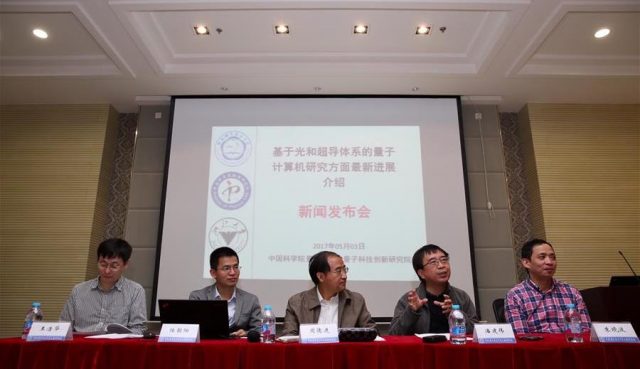
SHANGHAI, CHINA | Chinese scientists have built the world’s first quantum computing machine that goes far beyond the early classical — or conventional — computers, paving the way to the ultimate realization of quantum computing.
Scientists announced their achievement at a press conference in the Shanghai Institute for Advanced Studies of University of Science and Technology of China on Wednesday.
Scientists believe quantum computing could in some ways dwarf the processing power of today’s supercomputers. One analogy to explain the concept of quantum computing is that it is like being able to read all the books in a library at the same time, whereas conventional computing is like having to read them one after another.
Pan Jianwei, an academician of the Chinese Academy of Sciences and a leading quantum physicist, said quantum computing exploits the fundamental quantum superposition principle to enable ultra-fast parallel calculation and simulation capabilities.
In normal silicon computer chips, data is rendered in one of two states: 0 or 1. However, in quantum computers, data could exist in both states simultaneously, holding exponentially more information.
The computing power of a quantum computer grows exponentially with the number of quantum bits that can be manipulated. This could effectively solve large-scale computation problems that are beyond the ability of current classical computers, Pan said.
For example, a quantum computer with 50 quantum bits would be more powerful in solving quantum sampling problems than today’s fastest supercomputer, Sunway TaihuLight, installed in the National Supercomputing Center of China.
Due to the enormous potential of quantum computing, Europe and the United States are actively collaborating in their research. High-tech companies, such as Google, Microsoft and IBM, also have massive interests in quantum computing research.
The research team led by Pan is exploring three technical routes: systems based on single photons, ultra-cold atoms and superconducting circuits.
Recently, Pan Jianwei and his colleagues — Lu Chaoyang and Zhu Xiaobo, of the University of Science and Technology of China, and Wang Haohua, of Zhejiang University — set two international records in quantum control of the maximal numbers of entangled photonic quantum bits and entangled superconducting quantum bits.
Pan explained that manipulation of multi-particle entanglement is the core of quantum computing technology and has been the focus of international competition in quantum computing research.
In the photonic system, his team has achieved the first 5, 6, 8 and 10 entangled photons in the world and is at the forefront of global developments.
Pan said quantum computers could, in principle, solve certain problems faster than classical computers. Despite substantial progress in the past two decades, building quantum machines that can actually outperform classical computers in some specific tasks — an important milestone termed “quantum supremacy” — remains challenging.
In the quest for quantum supremacy, Boson sampling, an intermediate (that is, non-universal) quantum computer model, has received considerable attention, as it requires fewer physical resources than building universal optical quantum computers, Pan said.
Last year, Pan and Lu Chaoyang developed the world’s best single photon source based on semiconductor quantum dots. Now, they are using the high-performance single photon source and electronically programmable photonic circuit to build a multi-photon quantum computing prototype to run the Boson sampling task.
The test results show the sampling rate of this prototype is at least 24,000 times faster than international counterparts, according to Pan’s team.
At the same time, the prototype quantum computing machine is 10 to 100 times faster than the first electronic computer, ENIAC, and the first transistor computer, TRADIC, in running the classical algorithm, Pan said.
It is the first quantum computing machine based on single photons that goes beyond the early classical computer, and ultimately paves the way to a quantum computer that can beat classical computers. This achievement was published online in the latest issue of Nature Photonics this week.
In the superconducting quantum circuit system, a research team from Google, NASA and the University of California at Santa Barbara announced a high-precision manipulation of 9 superconducting quantum bits in 2015.
Now the Chinese team led by Pan, Zhu Xiaobo and Wang Haohua have broken that record. They independently developed a superconducting quantum circuit containing 10 superconducting quantum bits and successfully entangled the 10 quantum bits through a global quantum operation.
Chinese scientists aim to realize manipulation of 20 entangled photons by the end of this year, and will try to design and manipulate 20 superconducting quantum bits. They also plan to launch a quantum cloud computing platform by the end of this year.









